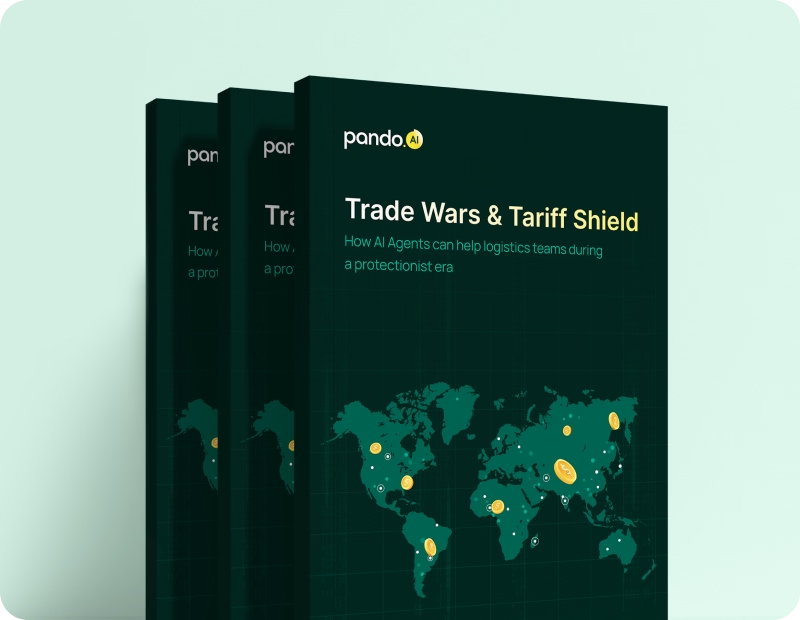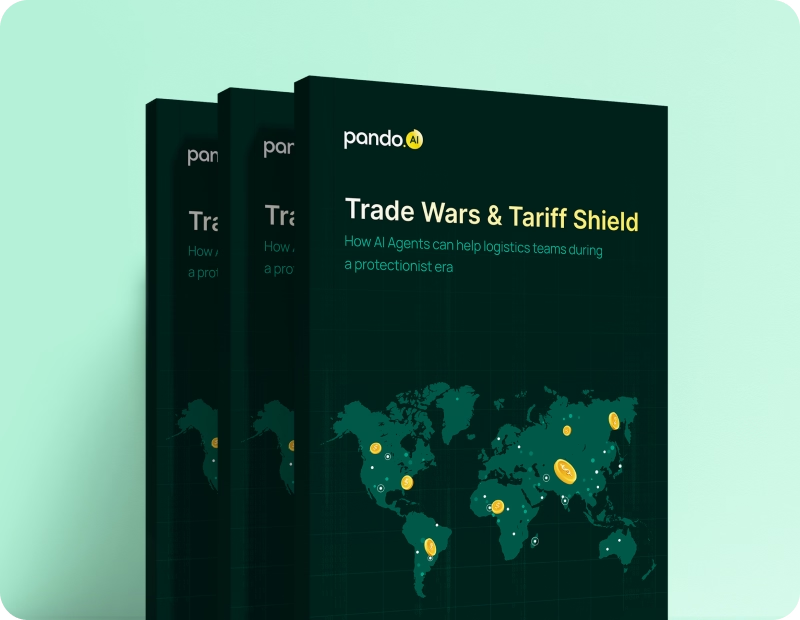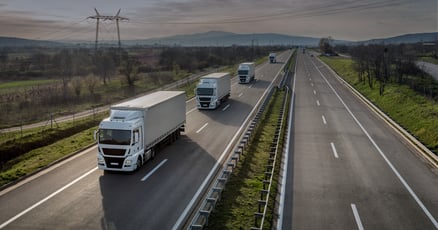-
Products Products
- Industry
- Initiatives
- Resources
- Company
- Book a demo

Before you go: Logistics leaders just dropped the truth on AI
The State of AI in Logistics 2025 is here — no hype, just real conversations and raw insights.
Driving green logistics with the power of route optimization
Power sustainability and green logistics with efficient, intelligent route planning.
Published on December 10, 2024 • 8 mins read
Rohit Lakshman

Power sustainability and green logistics with efficient, intelligent route planning.
Every vehicle, appliance, and transportation system leaves an environmental footprint. The emissions they generate trap heat, driving climate change, rising sea levels, and even increasing respiratory diseases.
Too grim? Let's pivot to solutions—because they're urgently needed. Logistics leaders can channel all that environmental concern into meaningful action by turning their operations greener.
If you're wondering why logistics is a focus point, freight emissions are growing five times faster than passenger emissions.
While the US government aims for net-zero emissions by 2050, embracing sustainable transportation today must lead the charge. Route optimization is the smartest way to deliver sustainability, cost efficiency, and operational excellence.
Curious to know how route planning relates to green logistics? This article dives into all you need to know, from why and how to best practices for implementing sustainable transportation.
Setting context: Impact of traditional route optimization
Before diving into green logistics, let's review the current state of route optimization.
Traditionally, the focus has been on cost and time efficiency. Businesses prioritized the fastest transportation routes to reduce expenses and meet deadlines.
Yes, it improves operational efficiency. But sticking to the old norms overlooks dynamic factors and last-minute developments. Soon enough, it leads to potential losses and supply chain waste.
Does this even happen? In the US, supply chain waste in terms of inefficiencies amounts to almost 720 billion dollars.
Static routing methods also mean missed opportunities. Not accounting for traffic, weather, and production plan changes results in failure on emerging priorities. Empty miles and late deliveries literally and figuratively turn money into fumes.
The traditional approach slowly widens the gap between you and route optimization's untapped potential. If your business steps beyond cost-cutting, you'll see smarter, greener logistics at the other end of the tunnel.
Why sustainability in logistics is now a dire necessity
While sustainability is a global concern, let's first understand why it falls to logistics.
Freight transportation alone accounts for 33% of emissions, and sustainability in logistics is nearing mandatory. However, the degree of adoption has the potential to achieve a competitive advantage in branding and efficiency.
Here are three key factors that underscore the growing importance of sustainability in logistics:
-
Tightening regulations
Logistics is making a big splash. That's why governments have tightened several emission regulations to make the most positive environmental impact.
In June 2024, the US EPA revised vehicle greenhouse gas standards to regulate what vehicles should be manufactured and used on the highway. While this has been deployed in phases, the regulations are undoubtedly growing more stringent.
Adopting green logistics helps achieve the net-zero emission vision. Plus, standardizing sustainable transportation is also vital in minimizing regulatory disruptions.
-
Climate concerns
Emissions, especially from fossil fuel consumption, have widespread implications. Global warming is a long-term result, but it isn't the only one. Your business's logistics processes and solutions affect even the quality of life in the area.
It significantly contributes to environmental challenges, such as rising sea levels and air pollution. This escalates the urgency of adopting sustainable transportation practices.
Eco-friendly alternatives in logistics, such as electric vehicles or optimized routes, reduce carbon footprint and environmental harm.
-
Shifting consumer preferences
Everyone, from clients to consumers, has begun prioritizing "eco-friendly" intent. 78% of US consumers now value and prioritize sustainability.
For businesses, this isn't just about going green—it's about staying relevant. Sustainability boosts brand reputation, fosters customer trust, and opens the door to long-term growth. But there's often the conundrum of where to focus sustainability first.
After all, customers will have a limited spending range.
Finding the balance! Consumers are willing to spend 9.7% more on sustainable products. While this shows intent, your business must know what function helps balance sustainability efforts and cost efficiency.
With its extensive operations and touchpoints, logistics offers a golden opportunity to slash environmental impact. Often, welcoming green logistics is one of the best functions for meeting evolving consumer demands and unlocking profitability.
Route optimization drives green logistics
We've covered quite a bit on how green logistics combines sustainable transportation with logistics efficiency. Now, let's review the most powerful and all-purpose solution: Route optimization.
What is route optimization? It's the process of planning the most efficient transportation routes. Modern route optimization involves AI, data analytics, and business intelligence to minimize mileage, idle time, fuel consumption, and more.
With cutting-edge solutions like Pando's multi-modal TMS (Transportation Management Systems), businesses can streamline transportation operations, driving logistics efficiency and environmental sustainability.
Here are four key ways route optimization powers green logistics for your business.
Reduced fuel consumption
Fuel savings are one of route optimization's most immediate benefits. By calculating the most efficient routes in real-time, businesses minimize detours. Experts like Pando offer TMS solutions that can also account for customer availability.
90% of the US transportation sector relies on petroleum, one of the most environmentally harmful fossil fuels. By reducing fuel consumption, route optimization becomes essential in reducing its impact.
Lower emissions
Route planning tools shorten the delivery route and help vehicles make minimal stops. This results in fewer miles driven, less time spent idling, and ultimately lower CO2 emissions.
Traffic insights from live GPS and market intelligence help drivers avoid congested routes and maintain driving speeds. This regularized vehicle use also facilitates the overall environmental impact.
With lower emissions through sustainable transportation, route planning tools adhere to regulatory standards and support sustainability goals.
Optimal vehicle utilization
Efficient vehicle loading and storage can significantly reduce the number of trips needed. Effective route optimization also involves improving the efficiency of executing every journey.
Need some references? Planning a vehicle to transport twenty boxes only to load ten dwindles resources and spikes CO2 emissions. This is often caused by mismatched vehicle timings or improper loading.
AI-powered solutions like Pando combine route optimization with 3D visualization. This way, loading teams have loading plans designed to maximize vehicle capacity. When integrated with ERP systems, route planning tools can even align vehicle timings with production schedules.
The result? Higher efficiency per journey and lower emissions per unit of cargo transported. Plus, fully utilized vehicles and efficient routes dramatically lower carbon footprints and per-vehicle costs.
Enhanced sustainability reporting
Route planning tools are more than logistics aids—they're rich data sources, too.
With built-in analytical dashboards, managing sustainability strategies becomes much more seamless. With GPS and IoT devices, route optimization can even transmit real-time fuel consumption, emissions, and efficiency data.
When aiming for high sustainability targets, route optimization also demonstrates a strong commitment to eco-friendly practices for customers and stakeholders. In short, precise monitoring and transparent reporting become effortless with route planning tools.
Putting it into context: 4 examples of sustainable route planning
Next, let's showcase why route optimization is one of the most sustainable ways of freight transportation. Here are four scenarios in which route planning improves logistics efficiency and sustainability.
1. Minimizing empty miles
Situation: A trucking company often returns its vehicles to the warehouse after deliveries without any return cargo. This leads to fuel wastage and increased emissions.
What route planning does here:
The business can deploy route optimization tools to identify backhaul opportunities. The algorithm matches vehicles with nearby pickup requests for the return trip.
Result: Empty miles are minimized, fuel is saved, and route efficiency spikes.
Is this a real issue? Yes, the American Transportation Research Institute (ATRI) found that empty miles make up 15-20% of trucking. Imagine the metric tonnes of emission.
2. Load consolidation
Situation: A distribution center sends multiple half-loaded trucks to the same area due to disorganized scheduling and inconsistent loading practices.
What route planning does here:
AI-powered TMS tools like Pando can review vehicle capacity and shipment stackability. This enables more efficient material loading, creating more space and combining shipments heading to similar destinations.
Result: More shipments are loaded into a single truck, the number of trips needed is reduced, and vehicle costs and emissions drop.
3. Off-peak hour deliveries
Situation: A fleet delivering to urban areas gets stuck in traffic during peak hours, leading to higher fuel consumption and extended delivery times.
What route planning does here:
Route optimization solutions consider local norms and off-peak hours when scheduling transport. They will also consider the fuel usage for alternative routes in case of time slots.
With live updates to insights, they can even incorporate dynamic buffer periods and notify drivers on when to leave for the delivery.
Result: Traffic congestion avoided, minimal idle time, and fuel-optimized
Efforts in the US! Cities like New York have promoted off-peak delivery programs to improve air quality and ease traffic.
4. Clustering deliveries
Situation: A courier company sends drivers to scattered delivery locations, wasting time and fuel.
What route planning can do here:
Route planning tools cluster deliveries by proximity, ensuring that vehicles cover nearby stops in a single trip.
Result: Travel distances are reduced, and overall efficiency improves.
Achieving AI-powered green logistics with Pando
While route optimization drives sustainability, its benefits go far beyond environmental impact. Route planning tools enhance fuel efficiency, reduce costs, and streamline operations. Plus, they boost brand reputation and foster customer trust.
A true win-win for your business, provided you have the right solution.
If you're looking for comprehensive, intuitive, and cutting-edge solutions, Pando is an ideal partner. It's TMS and freight procurement deliver predictive analytics, automation, AI algorithms, and real-time visibility. Pando ensures everything from carrier selection to shipment delivery is optimized with sustainability and efficiency at the forefront.
Ready to embrace operational excellence and green logistics? It might be time to explore what Pando can do for your business.
Book a demo today!
Subscribe to Pando blog and Crossroads newsletter now!
Stay up to date with the latest logistics, transportation, and supply chain tips and news.
Subscribe Here!













